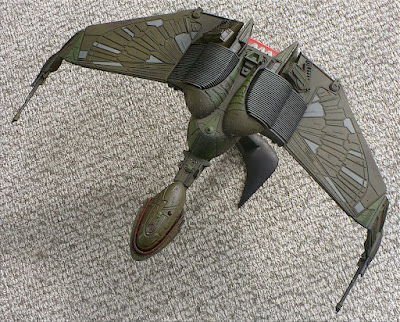




Here are some images of AMT's Klingon Bird of prey. In my view the best of the AMT Star Trek kits. From Wikipedia "
The Bird of Prey is one of the most common Klingon ships seen in the Star Trek franchise. First introduced in Star Trek III: The Search for Spock, the Bird of Prey has featured in five of the films and frequently appears in The Next Generation and Deep Space Nine. Industrial Light & Magic designed and built the Bird of Prey for Star Trek III, assisted by the film's director, Leonard Nimoy. In early drafts of the script, the Bird of Prey was to be a Romulan vessel; although this idea was later dropped, the Bird of Prey maintained its cloaking device as a plot point in the film and the Romulan bird feather patterns on its wings were kept. The Bird of Prey is the first Klingon vessel depicted with a cloaking device; all classes chronologically later in the series would also use a cloaking device. The wings of the Bird of Prey are able to move, lowering to attack, maintaining just above horizontal in flight mode and raising high when the ship lands. However, as the studio model's mechanism for moving the wings broke, in later Star Trek series' episodes the wings are usually fixed in either flight mode or attack mode. This was not rectified until the creation of a CGI model for the vessel. The studio models for the Bird of Prey were sold in the 2006 Christie's auction; the original model sold for US$307,200, while an enlarged wing, used for close-up shots in Star Trek V: The Final Frontier, was sold for US$8,400.
Although several variants are seen throughout the franchise, design notes state that the Bird of Prey has two main classes: the B'rel-class and the K'Vort-class. Both classes used the same studio model, differing in sizes in proportion to other starships depending on variant. The B'rel-class is a scout vessel, used for espionage, skirmishes and raids, while the K'Vort-class is a light cruiser. Both classes are armed with disruptor cannons mounted on the tips of the wings and a forward torpedo launcher, although the K'Vort-class possesses an extra two ship-mounted disruptor banks and a second torpedo launcher. Likewise, both classes are equipped with cloaking devices and are capable of impulse and warp speeds. With a crew of only 12 and a length of 160 meters, the B'rel-class is far smaller than the K'Vort-class, which measures 320 meters and possesses a crew of 300+. The interior of the Bird of Prey is similar to that of Douglas Trumbull's submarine-like designs for the K't'inga-class; some Birds of Prey are even shown with periscopes to allow the captain to personally target weapons. Despite relatively light armaments, Birds of Prey are shown to be effective craft; both the USS Enterprise and USS Enterprise-D are destroyed in part due to the activity of a Bird of Prey.

8 comments:
Always loved the Bird Of Prey. It seemed to be the only Star Trek vessel whose design seemed to serve a purpose.
Beautiful model too.
Thanks Jump Raven the Bird of Prey is one of my favorites as well.
It took them a long time to finally come out with the kit after the debut of Star Trek III. I have built several of these because they're fun and they take well to weathering.
Good work on your own Warren.
Dave
Thanks Dave I made mine a darker green than the instructions called for. I felt the pale green looked too cheesy.
Yes. The pale green is seen against a dark background in the movies of course. A dark Bird of Prey would just get lost. The dark green is more attractive in scale. I have seen a few of them painted in light green and they're kind of pukey.
Dave
Hence the term puke green 8{0
Very nice. This one is very cool looking. Are there technical manuals for the star trek ships as well?
Yes they're generally part of the Star Trek technical manuals. The hard things to find though are blueprints for individual ships.
Post a Comment